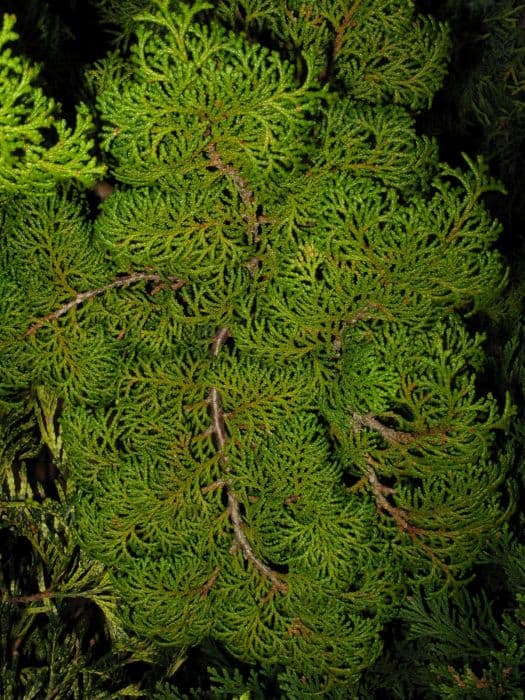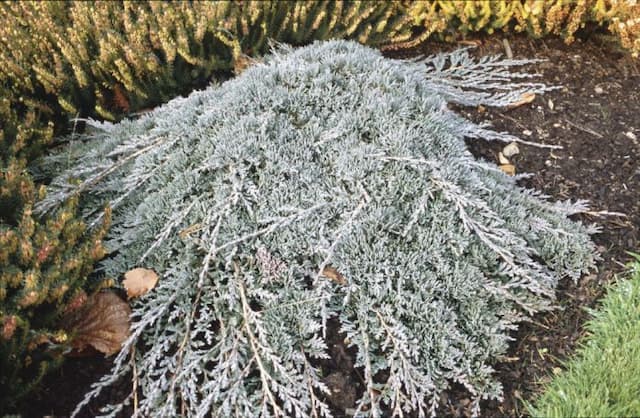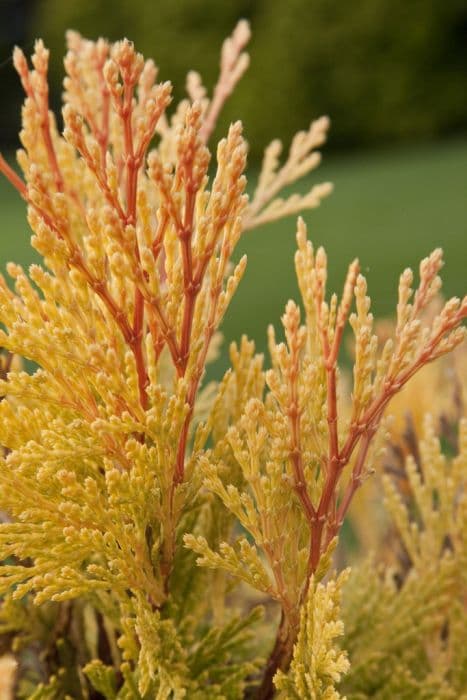Port Orford Cedar Chamaecyparis lawsoniana 'Imbricata Pendula'











ABOUT
The Chamaecyparis lawsoniana 'Imbricata Pendula', commonly known as the Weeping Lawson Cypress, is a visually striking conifer with a unique growth habit. This plant is characterized by its elegant, pendulous branches that drape downward, creating a curtain-like effect. The foliage is dense with a fine, feathery texture, composed of small scales that overlap each other tightly. It displays a lush green to bluish-green color, which can appear silvery from a distance due to the way the light catches the leaves. During the growing season, the Weeping Lawson Cypress may develop small cones that add to its ornamental value. The cones are usually inconspicuous, blending in with the foliage. This plant's dramatic weeping form and dense, graceful boughs make it a focal point in any landscape design where its unique silhouette can be showcased. Despite its distinctive appearance, the Weeping Lawson Cypress maintains an air of softness and delicacy due to the fine texture of its foliage and the gentle sway of its cascading branches.
About this plant
 Names
NamesFamily
Cupressaceae
Synonyms
Weeping Lawson Cypress, Slender Hinoki Cypress, Pendulous Lawson False Cypress
Common names
Cupressus lawsoniana 'Imbricata Pendula', Chamaecyparis lawsoniana 'Pendula', Cupressus lawsoniana 'Pendula'.
 Toxicity
ToxicityTo humans
The plant commonly known as Lawson's cypress is not highly toxic to humans. While it is not typically considered edible and ingestion should be avoided, it does not possess severe toxins that are known to cause serious harm if accidentally consumed in small amounts. However, there may be individuals with specific allergies or sensitivities who could experience mild stomach upset or dermatitis upon contact or ingestion. It is advisable to handle plants with care and keep them out of reach of children, who might be more tempted to ingest plant material.
To pets
Lawson's cypress is not known to be particularly toxic to pets such as cats and dogs. If pets happen to ingest a small amount of the plant, it is unlikely to cause significant harm. However, large amounts of ingestion could potentially lead to gastrointestinal upset, as with many non-food plants. To maintain pets' health and safety, preventing them from consuming plants is generally a good practice. If you suspect your pet has ingested a substantial amount of Lawson's cypress or is showing signs of illness, it is best to consult a veterinarian.
 Characteristics
CharacteristicsLife cycle
Perennials
Foliage type
Evergreen
Color of leaves
Green
Height
10-15 feet (3-4.5 meters)
Spread
4-6 feet (1.2-1.8 meters)
Plant type
Tree
Hardiness zones
5
Native area
North America
Benefits
 General Benefits
General Benefits- Aesthetic Appeal: Adds visual interest to the landscape with its narrow, conical shape and weeping branches.
- Erosion Control: Can help stabilize soil on slopes and prevent erosion.
- Habitat for Wildlife: Provides shelter and nesting sites for birds and other small wildlife.
- Privacy Screening: Dense foliage makes it ideal for creating a natural privacy screen.
- Windbreak: Can serve as a protective barrier against strong winds when planted in rows.
- Shade Provider: Can offer a cool, shaded area beneath its canopy during sunny days.
- Sound Barrier: Helps to reduce noise pollution when used in hedges or as a buffer.
- Low Maintenance: Generally requires minimal care once established, making it a convenient choice for gardeners.
- Year-round Interest: Evergreen foliage provides greenery throughout all seasons.
- Adaptability: Can grow in a variety of soil types, though it prefers well-drained soils.
 Medical Properties
Medical PropertiesThis plant is not used for medical purposes.
 Air-purifying Qualities
Air-purifying QualitiesThis plant is not specifically known for air purifying qualities.
 Other Uses
Other Uses- Woodworking Projects: The wood of the Lawson Cypress is valued for its durability and workability, making it a good choice for crafting furniture, decorative items, or even musical instruments.
- Sound Barriers: Due to its dense foliage, it can be used in landscaping to reduce noise pollution when planted in rows along roads or between properties.
- Scented Items: The foliage of Lawson Cypress has a pleasing scent and can be used in potpourris or as a natural air freshener.
- Privacy Screens: The plant can be used to create living privacy screens or hedges due to its dense growth habit and the ability to be pruned into various shapes.
- Theme Gardens: Lawson Cypress can be incorporated into Japanese or Zen gardens due to its elegant form and subtle textures that enhance the overall aesthetic.
- Topiary Art: The plant can be carefully pruned into interesting shapes and forms, making it a candidate for topiary art in formal gardens or parks.
- Erosion Control: Its robust root system makes it effective for stabilizing slopes and preventing soil erosion in landscapes prone to such issues.
- Windbreaks: When planted in rows, Lawson Cypress can act as a windbreak to protect other plants or structures from strong winds.
- Christmas Trees: Although not as common as other species, young Lawson Cypress trees can be used as live Christmas trees that can be replanted later.
- Wildlife Habitat: Lawson Cypress trees can provide shelter and nesting sites for birds and other local wildlife within a garden or landscape setting.
Interesting Facts
 Feng Shui
Feng ShuiThe Lawson's Cypress is not used in Feng Shui practice.
 Zodiac Sign Compitability
Zodiac Sign CompitabilityThe Lawson's Cypress is not used in astrology practice.
 Plant Symbolism
Plant Symbolism- Longevity: Chamaecyparis, also known as Lawson's Cypress, is an evergreen conifer which symbolizes a long life due to its ability to live for many years.
- Endurance: This plant's hardy nature and ability to withstand many environments represents the ability to endure hardships.
- Serenity: Lawson's Cypress often creates a sense of calm and tranquility in landscapes, which is why it is associated with peace and serenity.
- Protection: Historically, evergreens like the Lawson's Cypress were thought to ward off evil spirits, thus symbolizing protection and safety.
 Water
WaterThe Weeping Alaskan Cedar requires regular watering to maintain moist, well-drained soil, especially during dry spells. Water the tree with about 1 to 2 gallons of water per week, adjusting as needed for rainfall and weather conditions. During the first growing season, it's important to water deeply once or twice a week to help establish a strong root system. For mature trees, deep, less frequent watering is preferred to encourage deep root growth. It's best to water in the mornings or evenings to reduce evaporation and ensure the water penetrates the soil.
 Light
LightWeeping Alaskan Cedar thrives best in full sun to partial shade. It requires an area that receives at least 6 hours of direct sunlight daily, though it can tolerate some light shade. Avoid placing it in deep shade, as this can lead to sparse foliage and a less vigorous plant. An ideal spot would be one where it's exposed to the morning sun and protected from the intense afternoon heat.
 Temperature
TemperatureThe Weeping Alaskan Cedar is hardy and can tolerate a temperature range from about -20 degrees Fahrenheit to 70 degrees Fahrenheit. However, it grows best in temperatures between 40 and 60 degrees Fahrenheit. Avoid exposing the tree to prolonged temperatures above 80 degrees Fahrenheit, as it can stress the plant.
 Pruning
PruningPrune the Weeping Alaskan Cedar to maintain its shape and remove any damaged or diseased branches. The best time for pruning is late winter or early spring before new growth starts. Pruning annually or as necessary can help manage the size of the tree and encourage a more dense, attractive form. Avoid heavy pruning, as this can damage the tree.
 Cleaning
CleaningAs needed
 Soil
SoilLawson’s Cypress 'Imbricata Pendula' thrives in moist, well-drained acidic soil with a pH of 5.0 to 6.0. A soil mix with peat moss, compost, and perlite or sand is ideal to ensure good drainage and aeration.
 Repotting
RepottingLawson’s Cypress 'Imbricata Pendula' typically does not need regular repotting as it is a slow-growing tree. Repot young plants every 2-3 years; mature plants rarely need repotting and prefer undisturbed roots.
 Humidity & Misting
Humidity & MistingLawson’s Cypress 'Imbricata Pendula' does well in moderate to high humidity levels, which mirror its natural habitat in the Pacific Northwest.
 Suitable locations
Suitable locationsIndoor
Not suitable for indoor growth; requires open space.
Outdoor
Plant in full sun to partial shade, shield from strong winds.
Hardiness zone
5-8 USDA
 Life cycle
Life cycleChamaecyparis lawsoniana 'Imbricata Pendula', commonly known as Lawson's Cypress, begins its life cycle with seed germination, which is influenced by moisture, temperature, and light conditions. The emergent seedlings quickly establish a root system and begin to grow upward with feathery, pendulous foliage that characterizes this cultivar. After a few years, the plant enters the juvenile phase, developing a conical shape with branches that weep gracefully, eventually maturing into a stately tree reaching up to 200 feet in its native habitat. Sexual maturity is reached in several years, when the Lawson's Cypress begins to produce cones—small male cones release pollen, which fertilizes the female cones leading to seed development. The mature phase can last for many decades, where the tree undergoes continuous cycles of growth, reproduction, and cone production. In the final stage of its life cycle, the Lawson's Cypress may succumb to age, environmental stress, or disease, leading the tree to decline and eventually die, returning nutrients to the soil upon decomposition.
 Propogation
PropogationPropogation time
Spring-Early Summer
Propogation: Chamaecyparis lawsoniana 'Imbricata Pendula', commonly known as the Weeping Lawson's Cypress, is typically propagated through semi-hardwood cuttings. The best time for taking cuttings is during the late summer to early fall, when the wood is partially matured. The process involves selecting healthy, disease-free semi-hardwood stems and cutting pieces of about 4 to 6 inches (approximately 10 to 15 cm) in length. Cuttings should have several leaf nodes and be taken just below a node, as this is where the rooting hormone can be most effectively applied. The base of the cutting is then dipped in rooting hormone to encourage root development and is planted in a well-draining rooting medium such as a mixture of peat and perlite. To maintain high humidity around the cutting, a plastic cover or dome can be used. The cuttings are kept in a sheltered location with indirect light until they root, which usually takes several weeks to a few months.









